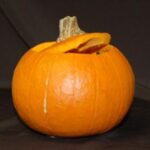My mother always grows pumpkins in her yard every year. Mixed in among her flowers and plants are big globes of orange scattered here and there, looking like the remnants of a basketball game. I swear my mother can plant a Pepsi can and grow a whole field of Pepsi with no effort at all. When she plants her pumpkin seeds, she steps outside and throws a handful of seeds into the air then slips into a brain fog and bounces around the yard doing whatever until someone gets worried about her and sends out a search party. She always lovingly gives us as many pumpkins as we want to decorate for fall. But my mother doesn’t realize that the pumpkins she’s planting should only be used for decoration, not baking. I must admit, I do not look forward to the endless begging to can all these pumpkins she grows every fall. Note to self: Call momma after writing this article and tell her I’ll be out of town until next year.
Jack-o-lantern pumpkins are usually used for fall decoration. However, in my endless search of the internet, some people do use smaller versions of these pumpkins for baking. The information I’ve read recommends that for baking purposes, you need to use the small, sweet pumpkins that are grown specifically for baking. The meat found inside these pumpkins is less stringy and smoother than jack-o-lantern pumpkins. If you want to use pumpkins for baking, try the Sugar Pumpkin or Baby Pam. These pumpkins are great for pies, muffins, soups, cookies or breads and can also be used for jack-o-lanterns. Why not kill two birds with one stone, as the saying goes.
If you want to use fresh pumpkin, versus canned pumpkin, there isn’t much of a difference in nutritional value. However, fresh pumpkin beats canned pumpkin in a taste test hands-down. Pumpkins, like tomatoes, are botanically classified as a fruit but regarded in the cooking world as a vegetable. Pumpkins are rich in vitamin A, vitamin C, calcium, zinc, potassium, alpha and beta carotene and are also high in fiber.
Baking with fresh pumpkin requires more effort and time than using canned. There are steps to go through before the pumpkin can be used in your recipes. If you’ve decided to use fresh pumpkin for your recipes, plan ahead. Choose a pumpkin with no blemishes and keep in mind whether you want just enough pumpkin for your recipe, or you’d rather have enough to preserve. You should choose your pumpkin size accordingly. A four pound sugar pumpkin will yield about a cup and a half of mashed pumpkin. Pumpkin can be refrigerated for three or four days, while frozen pumpkin can be kept for up to six months. You can also preserve pumpkin for a longer period of time by canning. The following are some methods for extracting pumpkin flesh for baking.
The Baking Method
Cut the pumpkin of choice in half and cut off the stem part. Scoop out the stringy insides along with the seeds. Keep these seeds! Bake them in different ways and eat them later. They’re good for you! (How to bake pumpkin seeds is another animal.) Place the halves of the pumpkin cut side down in a baking dish and cover with foil. Bake at 375 degrees for about and hour and a half. When the pumpkin is cool enough to handle, scoop out the flesh. If your recipe calls for pumpkin puree, mash it with a potato masher or a food processor if you’re fortunate enough to have one.
The Boiling Method
Again, cut the pumpkin in half, cut off the stem and scoop out the stringy insides. Peel and cut the pumpkin into chunks. Cover with water in a saucepan and bring to a boil. Cook until the pumpkin is tender. Wait until the pumpkin is cool then mash or puree in a food processor if your recipe calls for pumpkin puree. (There’s that machine again that I can’t use because my husband broke it! Thanks, honey.)
The Microwave Method
Use the same method as the two listed above to prepare the pumpkin, cutting the goody into chunks. Microwave the pumpkin on high for about six to seven minutes per pound. I would keep an eye on it because your microwave may cook differently.
How to Drain Excess Water from the Pumpkin Puree
If you find that your pumpkin is a little too soupy, put some flattened coffee filters or a cheese cloth into a strainer and put the strainer in a bowl then put the bowl in the fridge overnight. That should help.
Once you’ve painstakingly produced your own pumpkin puree like the early settlers did long, long ago, you can use it in just about every recipe you have. Making your own pumpkin puree is a lot of work and takes a lot of time. But you know what? There may come a day in this old world when we have to revert back to growing and making our own food products if we want to eat. That’s something to think about! Have fun with your pumpkin!




